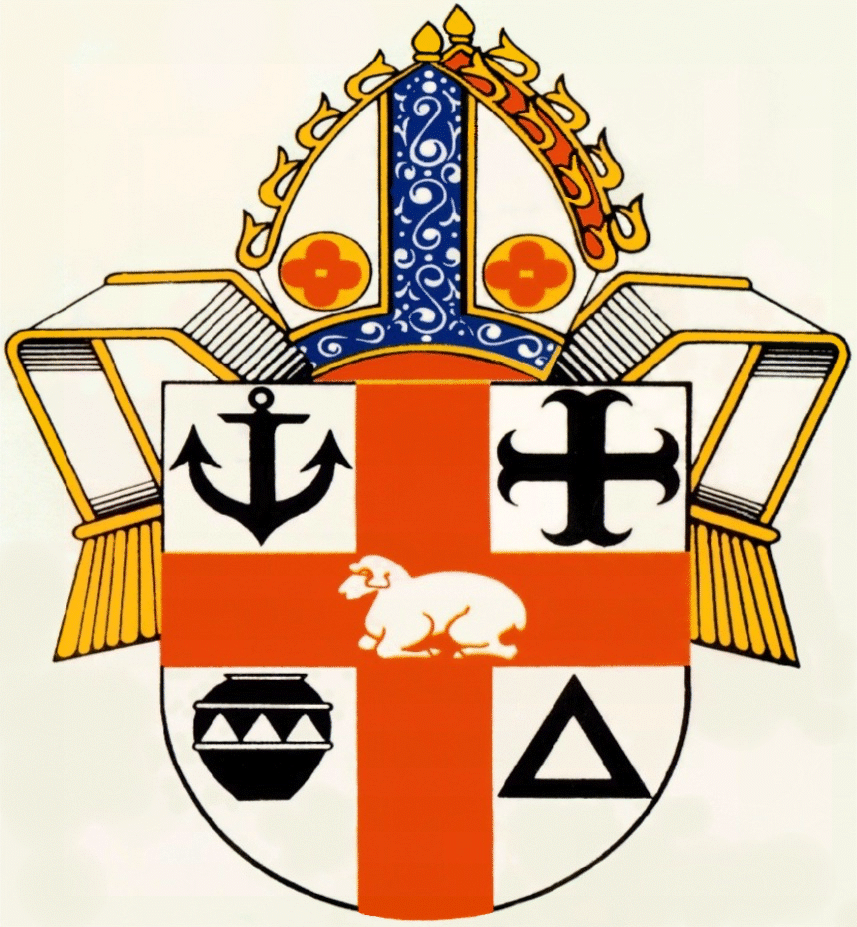
DIOCESE of PORT ELIZABETH, Church of the Province of Southern Africa
BISDOM van PORT ELIZABETH, Kerk van die Provinsie van Suider-Afrika
IDAYOSISI YaseBHAYI, Ibandla yePhondo loMzantsi Afrika
Diocese established in 1970, a division of the Diocese of Grahamstown.
Cathedral: St Mary the Virgin, Port Elizabeth.
Bishop’s residence: Bishop’s House, Walmer.

These arms were registered by the Bureau of Heraldry on 28 April 1978. The blazon reads:
Arms: Argent, on a cross Gules, between in dexter chief an anchor, in sinister chief a cross moline, in dexter base a clay pot and in sinister base a triangle Sable void of the field, a lamb couchant proper, the shield ensigned with a mitre proper.
There is no motto, and as is usual in ecclesiastical arms, there is no crest. The mitre or bishop’s formal headdress stands in the place of a helmet and crest.
About the arms:
The red cross is the familiar emblem of St George, patron saint of England, and forms the basis of many coats of arms of Anglican churches, not only in England but in many other parts of the world. It is taken in this instance from the arms of the Diocese of Grahamstown, which are: Argent, a cross gules; in the first quarter an anchor sable.
On the website of the Port Elizabeth Diocese the explanation reads inter alia: “The red cross is the atoning cross of Christ, and the anchor demonstrates that we are steadfast in the faith. It is also a link with our seaboard and the ships that sail there.”
While the anchor is clearly derived from the arms of the Grahamstown Diocese, it is in fact a symbol of the Cape Province (and Cape Colony). It can also be seen as a link with the City of Port Elizabeth, since the municipal arms include two anchors added as a mark of difference from the arms of Sir Rufane Donkin.
The cross moline (in the second quarter) is taken from the arms of the town of Uitenhage. Its colours have been reversed; the town’s arms are those of its namesake, Commissioner-General Jacob Abraham Uitenhage de Mist, the senior official of the Batavian Republic during its rule of the Cape Colony (1803-06), whose family arms were: Sable, a cross moline argent.
The clay pot is a symbol of fellowship and a reminder of the large number of black members of the Diocese of Port Elizabeth.
The triangle symbolises the Trinity, but also alludes to the Donkin Memorial, the pyramid erected on the Donkin Reserve, at the heart of Port Elizabeth’s historic Central Hill area. The pyramid can also be seen in the arms of Livingstone Hospital, and Pearson and Lawson Brown high schools.
The diocesan website explains the lamb as “the Lamb of God, who died for us and who calls us to His joyful service, ‘not only with our lips but in our lives’ ”.
It also symbolises the vast farming areas of the Karoo included in the diocese, as well as the textile industry of Port Elizabeth and Uitenhage. As a heraldic symbol the Lamb of God or Agnus Dei is usually standing, and supporting a staff bearing a banner of the cross (usually the red cross on white of St George or St Michael, but occasionally St Andrew’s white saltire on blue). However, in view of its position in the centre of the cross its seated position, without the staff, is appropriate, especially in the light of its secondary symbolism.
The diocesan website explains the mitre: “The Mitre is over all, set there to remind us that the Bishop is our Father in God, concerned for us all and for all of our needs.”
Hanging from the back of the mitre are two ribbons, called lappets or, in Latin infulæ vitæ, which in a coat of arms are often displayed in a manner similar to the mantling found in secular arms. In this case the lappets are displayed towards the edge of the shield and hang down its sides.
About the diocese:
The Diocese of Port Elizabeth, which covers a region stretching along the coast from Blueliliesbush in the Tsitsikamma to Kenton-on-Sea and north through the eastern Karoo to Colesberg, near the Orange River, was formed in 1970, when it was separated from the Diocese of Grahamstown.
The Anglican Church has been active in this region since 1825, when Irish 1820 Settler the Rev Francis McClelland became the first colonial chaplain based in Port Elizabeth. This was the beginning of the city’s oldest parish, St Mary the Virgin.
When it was first proposed to establish a colonial bishopric for the Cape Colony, it was initially suggested that the bishop be based in Uitenhage.
When Bishop Robert Gray, the first Anglican bishop appointed to the colony, eventually arrived as Bishop of Cape Town in 1848, he had already appointed Nathaniel Merriman as Archdeacon of Grahamstown, responsible for the entire eastern half of the Cape Colony. This was said at the time to be the first appointment of an archdeacon in Africa since the time of the Early Church. When John Armstrong arrived in 1854 as the first Bishop of Grahamstown, Archdeacon Merriman was, for a time, relocated to Uitenhage. Merriman himself became third Bishop of Grahamstown in 1871.
The name of the diocese and of the Church of the Province appear at the top of this page in English, Afrikaans and isiXhosa, since these are the three official languages of the diocese.
The Diocese of Port Elizabeth has its own website.

Back to Armoria ecclesiastica index
Comments, queries: Mike Oettle